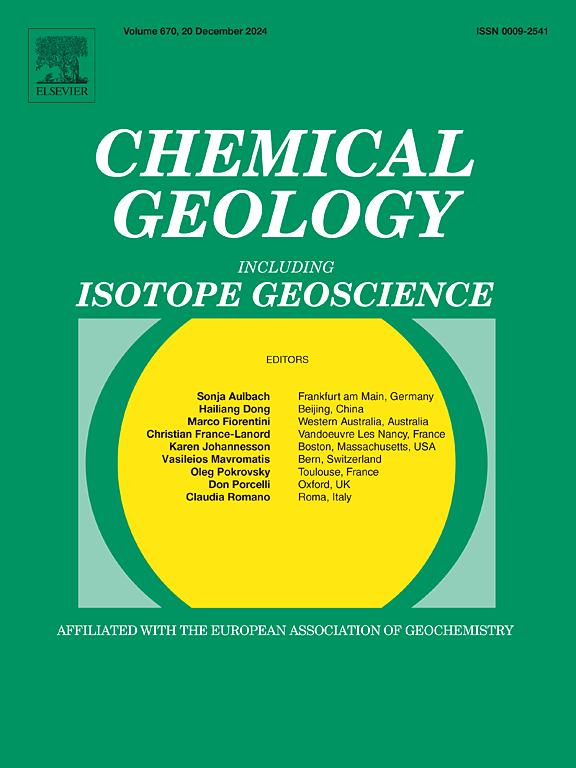Controls over cesium and rubidium contents of sedimentary rocks
IF 3.6
2区 地球科学
Q1 GEOCHEMISTRY & GEOPHYSICS
引用次数: 0
Abstract
In nature, Cs and Rb follow K, which is a much more abundant but chemically similar element. Data for these elements and their mineral carriers were acquired by the combined ICP-OES/ICP-MS (Inductively Coupled Plasma Optical Emission Spectroscopy/Inductively Coupled Plasma Mass Spectrometry) techniques and quantitative XRD (X-ray diffraction), supplemented by multivariate regression analysis, in order to detect controls over cesium and rubidium contents of clastic sedimentary rocks. The sample material comprised clay fractions of bentonites and paleosols, dominated by illite-smectite, and bulk mudstones, sandstones, paleosols, bentonites, basalts, and tuffs from several European basins, ranging from the Proterozoic to Miocene. Results indicate that Rb and Cs contents of clastic sedimentary rocks, and of mudstones in particular, are controlled by the relative concentrations of K-feldspar, micas, and illite-smectite, thus detrital and late diagenetic components of these rocks, and concentrations of Rb and Cs in these minerals. The concentrations of Cs in some illite-smectites, significantly higher than upper continental crust (UCC) averages, indicate hydrothermal alteration or, in case of paleosols and bentonites, can be inherited from anomalous parent rocks. K, Cs, and Rb contents of normal mudstones (unaffected by the hydrothermal fluids or anomalous parent rocks), whether marine or freshwater, are close to the UCC values. In normal mudstones of our collection, feldspars contain 0 to 22 % of Cs and 0 to 41 % Rb, micas 0 to 57 % Cs and 0 to 48 % Rb, and illite-smectite 32 to 100 % Cs and 17 to 100 % Rb, both mostly non-exchangeable and ‘fixed’ in the illite structure. The collected data do not support the use of Rb/K as a paleosalinity proxy and call for careful use of Rb and Cs in chemostratigraphy. The presented relationships indicate that Cs/K and Rb/K ratios in illite-smectite are controlled by the chemistry of fluids, which promote crystallization of illite during burial. Normal diagenetic fluids precipitate illite with, on average, 2.4 times more Cs and 70 % more Rb than the UCC values. In “abnormal” illites, the average Cs and Rb values are 18 and 2.5 times higher than the UCC, respectively. It is confirmed that thin illite crystals have higher Rb/K and Cs/K ratios, tentatively explained by the “supply and demand” mechanism: high ratio between the concentrations of Rb and Cs in pore fluids and the volume of neoformed illite at the beginning of illite crystallization. Major sources of Cs in diagenetic pore fluids in sedimentary basins are detrital micas or hydrothermal fluids invading those basins. The impact of Cs and Rb sorption at illite and mica wedges and/or frayed edges on the total budgets of these elements cannot be evaluated from our data.
沉积岩中铯和铷含量的控制
在自然界中,Cs和Rb紧随K之后,K是一种丰富得多但化学性质相似的元素。采用ICP-OES/ICP-MS(电感耦合等离子体光学发射光谱/电感耦合等离子体质谱)和x射线衍射(x射线衍射)相结合的方法获取这些元素及其矿物载体的数据,并结合多元回归分析,检测碎屑沉积岩中铯和铷含量的控制因素。样品材料包括膨润土和古土壤的粘土组分,主要是伊利石-蒙脱石,以及来自几个欧洲盆地的大块泥岩、砂岩、古土壤、膨润土、玄武岩和凝灰岩,范围从元古代到中新世。结果表明,碎屑沉积岩,特别是泥岩的Rb和Cs含量受钾长石、云母和伊利蒙石的相对浓度控制,因此这些岩石的碎屑组分和晚期成岩组分,以及这些矿物中Rb和Cs的浓度。某些伊利石蒙脱石的Cs含量明显高于上大陆地壳(UCC)平均值,表明热液蚀变或古土壤和膨润土可能继承自异常母岩。正常泥岩(不受热液流体或异常母岩的影响)的K、Cs和Rb含量,无论是海相泥岩还是淡水泥岩,都接近UCC值。在我们收集的正常泥岩中,长石含有0 - 22%的Cs和0 - 41%的Rb,云母含有0 - 57%的Cs和0 - 48%的Rb,伊利石-蒙脱石含有32 - 100%的Cs和17 - 100%的Rb,两者在伊利石结构中大多是不可交换的和“固定”的。所收集的资料不支持将Rb/K作为古盐度指标,在化学地层学中应谨慎使用Rb和Cs。这些关系表明,伊利石-蒙脱石中的Cs/K和Rb/K比值受流体化学控制,在埋藏过程中促进伊利石的结晶。正常成岩流体析出的伊利石,Cs比UCC值平均高2.4倍,Rb比UCC值平均高70%。在“异常”伊利石中,Cs和Rb的平均值分别是UCC的18倍和2.5倍。证实了薄的伊利石晶体具有较高的Rb/K和Cs/K比值,初步解释了“供需”机制:伊利石结晶开始时孔隙流体中Rb和Cs浓度与新生伊利石体积之比较高。沉积盆地成岩孔隙流体中碳元素的主要来源是碎屑云母或侵入盆地的热液。Cs和Rb在伊利石和云母楔形和/或磨损边缘的吸附对这些元素的总收支的影响无法从我们的数据中评估。
本文章由计算机程序翻译,如有差异,请以英文原文为准。
求助全文
约1分钟内获得全文
求助全文
来源期刊

Chemical Geology
地学-地球化学与地球物理
CiteScore
7.20
自引率
10.30%
发文量
374
审稿时长
3.6 months
期刊介绍:
Chemical Geology is an international journal that publishes original research papers on isotopic and elemental geochemistry, geochronology and cosmochemistry.
The Journal focuses on chemical processes in igneous, metamorphic, and sedimentary petrology, low- and high-temperature aqueous solutions, biogeochemistry, the environment and cosmochemistry.
Papers that are field, experimentally, or computationally based are appropriate if they are of broad international interest. The Journal generally does not publish papers that are primarily of regional or local interest, or which are primarily focused on remediation and applied geochemistry.
The Journal also welcomes innovative papers dealing with significant analytical advances that are of wide interest in the community and extend significantly beyond the scope of what would be included in the methods section of a standard research paper.
 求助内容:
求助内容: 应助结果提醒方式:
应助结果提醒方式:


